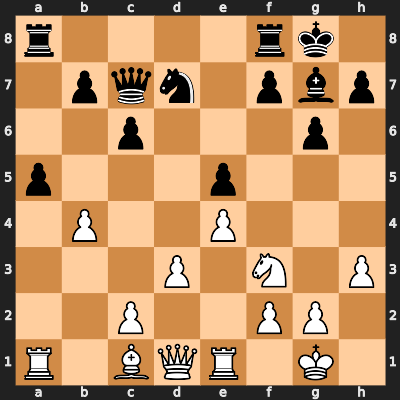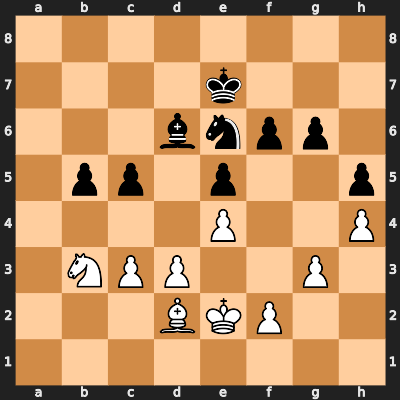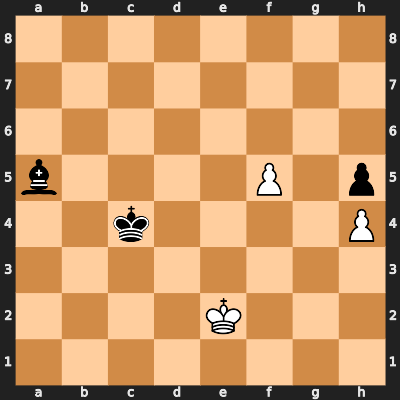Two Move Chess
In international chess it is widely recognized that the player with the white piecese has a slight first-move advantage. On her move, the player with the white pieces surveys a board where each player has made the same number of moves. By contrast, on his move the player with the black pieces faces a board where he is always one move behind his opponent.
Revised Double Move Chess (also known as Chess2) is a chess variant that is designed to remedy White's first move advantage in a manner similar to Balanced Marseillais Chess and Doublemove Chess, while adhering more closely to the play of international chess.
Setup
The board, pieces, and starting position for Chess2 are the same as in international chess.
Pieces
The pieces in Chess2 are exactly the same as in international chess.
Rules
- The starting position in Revised Double Move Chess (Chess2) is the same as in international chess. White begins the game with a single move. From then on, each player makes either one or two moves per turn. Each of these moves must be individually legal according to the rules of international chess for the current position on the board.
- When making two moves in a turn, a player cannot move a piece twice. For example, if a player castles on the first move of a two move turn, she cannot move either the king or castling rook on the second move of that turn. A player may take a turn with only a single move if any of these conditions apply to that move:
- The move places the opponent in check (or checkmate)
- The move provides an opportunity for an en passant capture
- The move captures an opponent's piece
- The move promotes a pawn
- After a player has made a single move, his opponent immediately also takes a turn with a single move (unless the game has ended in checkmate). This move, known as a response move, does not itself cause the next turn to be a response move even if it meets one of the criteria above.
- Check and checkmate are evaluated exactly as in international chess for each position on the board (i.e. two separate positions are evaluated on a two move turn). Stalemate has a slight twist when compared to international chess. If at the start of his turn a player is not in check and has no available legal two move turns and no available legal single move turns, the game ends in stalemate. For example, if a player is reduced to having only the King on the board the game is very likely to end in stalemate, as the only continuations for that player are single moves that catpure an opponent's piece and response moves.
- Because each move of a two move turn must be legal according to the rules of international chess, a player who is in check must escape from check on the next move--if she has a two move turn this must occur on the first of those moves. Likewise, if a player has an opportunity to capture an opponent's pawn en passant, the pawn can only be captured on the next move. It cannot occur on the second move of a two move turn.
- Each position created by a two move turn is included in the count toward a draw by threefold repetition, or toward a draw by the Fifty move rule (or the Seventy-five move rule).
- A double move in Chess2 is recorded with a comma separating the standard notation for each of the two moves. For example, "Nf6,d5."
- While learning to play Chess2, players may agree to verbally announce "single move" and "response" while taking single move and response turns, in a manner similar to the verbal announcement of "check" that beginners often agree to make in international chess.
Notes
In Revised Double Move Chess (Chess2), each player usually begins her turn facing a board where she has made one less move than her opponent and ends it having made one more move than her opponent. When making a single move, she instead chooses to catch up to her opponent in the number of moves taken. After the response move, she again faces a board where she has made one less move than her opponent. This situation is maintained for each player throughout the game, providing a balance between the players in terms of the number of moves taken that does not exist in international chess.
Example 1
In this example, White makes a single move that places Black in check, and Black blocks the check with a single response move. Double moves are recorded in standard notation, separated by a comma. In this and all following examples, single moves are shown in bold text, and response moves are shown in bold italics. By convention, the first move by White can be considered a response move.
| 1.e4 | c5,d6 |
| 2.Bb4+ | Nd7 |

Example 2
In most situations where a player contemplates a single move turn, he has the strategic choice of either making a single move or taking a two move turn in which only the second move satisfies one of the criteria for a single move turn. This example is nearly the same as Example 1, except that White places Black in check on the second move of a two move turn.
| 1.e4 | c5,d6 |
| 2.Nf3,Bb5+ | Nd7,Nf6 |

Example 3
In this example Black makes a single move that provides an en passant capture opportunity. In this case, White does not capture en passant in her response move.
| 1.d4 | Nf6,c5 |
| 2.c4,d5 | e5 |
| 3.Nc3 |

Example 4
Here is an entire game of Chess2. This game is based on the game played between Magnus Carlsen and Fabiano Caruana in the third round of the World Chess Championship 2018 match on 2018-11-12. The move order has been changed in a number of places from the original game in order to construct a legal game of Chess2. Although players of this caliber would certainly make many different strategic choices if they had actually been playing Chess2, this game illustrates that Chess2 is very similar to international chess even while providing a more balanced game.
| 1.e4 | c5,Nc6 |
| 2.Nf3,Bb5 | g6,Bg7 |
| 3.Bxc6 | dxc6 |
| 4.d3,O-O | Qc7,e5 |
| 5.Re1,a3 | Nf6,O-O |
| 6.b4,Nbd2 | Bg4,cxb4 |
| 7.h3,axb4 | Bxf3 |
| 8.Nxf3 | a5,Nd7 |

| 9.bxa5 | Rxa5 |
| 10.Bd2,Qb1 | Raa8,Rfe8 |
| 11.Qb4,Bc3 | b5,f6 |
| 12.Rxa8 | Rxa8 |
| 13.Ra1,Kf1 | Rxa1+ |
| 14.Bxa1 | Qa7,Kf7 |
| 15.Bc3,Ke2 | Qa2,Bf8 |
| 16.Qb2,g3 | Qxb2 |
| 17.Bxb2 | Nc5,h5 |
| 18.Bc3,Nd2 | Ne6,Bd6 |
| 19.Nb3,Bd2 | Ng5,c5 |
| 20.h4,c3 | Ne6,Ke7 |

| 21.Be3,Kd1 | Kd7,f5 |
| 22.Kc2,Nd2 | fxe4 |
| 23.dxe4 | c4,Nc5 |
| 24.Kd1,Bxc5 | Bxc5 |
| 25.Ke2 | Kc6,b4 |
| 26.cxb4 | Bxb4 |
| 27.Nf1,f4 | Kc5,exf4 |
| 28.gxf4 | Ba5 |
| 29.Ne3,f5 | gxf5 |
| 30.Nxc4 | Kxc4 |
| 31.exf5 | ½ – ½ |

 This 'user submitted' page is a collaboration between the posting user and the Chess Variant Pages. Registered contributors to the Chess Variant Pages have the ability to post their own works, subject to review and editing by the Chess Variant Pages Editorial Staff.
This 'user submitted' page is a collaboration between the posting user and the Chess Variant Pages. Registered contributors to the Chess Variant Pages have the ability to post their own works, subject to review and editing by the Chess Variant Pages Editorial Staff.
By Ted Larson Freeman.
Last revised by Ted Larson Freeman.
Web page created: 2021-08-09. Web page last updated: 2021-08-26